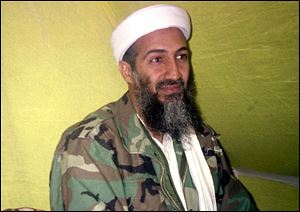
Bin Laden's journal plotted new attacks
5/12/2011
Osama bin Laden was involved, not just an inspirational figurehead, U.S. officials say.
WASHINGTON -- Osama bin Laden kept a personal journal in which he contemplated how to kill as many Americans as possible, including possible terrorist attacks against Los Angeles, Chicago, and Washington, according to U.S. officials.
The handwritten journal was in a vast cache of digital and printed material hauled from bin Laden's hideout after Navy SEALs killed him last week in Abbottabad, Pakistan.
One official described the private journal as full of planning ideas and outlines of potential operations, "aspirational guidance" on how to kill the maximum number of people, rather than specific proposals or plots that were actually under way.
In one passage, bin Laden wondered how many Americans would have to die in U.S. cities to force the U.S. government to withdraw from the Arab world. He concluded it would require another mass murder on the scale of the attacks of Sept. 11, 2001, to spur a reversal in U.S. policy, a U.S. official said.
Officials, speaking on condition of anonymity, declined to provide details about potential plots in Los Angeles and Chicago. Bin Laden discussed an operation in Washington, one official said, "because of its iconic value."
Among bin Laden's recorded thoughts: Strike smaller cities; target trains as well as planes; above all, kill as many Americans as possible in a single attack.
A CIA-led multiagency task force continues to scrutinize data from five computers, dozens of flash drives, and other devices that were taken from bin Laden's walled compound. The analysts have not found evidence of an imminent threat of an attack by al-Qaeda or its affiliates around the globe, officials said.
But the initial analysis has determined that bin Laden was in regular communication with several deputies, including al-Qaeda's putative operations chief, Atiyah Abd al-Rahman, officials said. The messages were sent primarily by couriers carrying computer flash drives, the official said.
The intelligence has overturned, according to officials, the long-held conventional wisdom that bin Laden was an inspirational figurehead so isolated that he cut off communications and played no operational role in terrorist attacks or plots.
"These assumptions [are] going out the window," this official said.
Every day this week, intelligence officials across the government have been briefed about new information developed from the intelligence haul, one U.S. official said.
The messages to al-Rahman, a Libyan in his mid-30s, have drawn special interest.
Al-Rahman joined bin Laden in Afghanistan as a teenager in the 1980s. U.S. officials believe al-Rahman took over the role as al-Qaeda's No. 3 figure after Sheikh Said al-Masri was killed in a missile strike from a CIA drone in Pakistan's tribal area in May, 2010, said a former Pentagon official. Al-Rahman is now believed to be in Pakistan.
Also Wednesday, members of Congress and other officials got a first chance to examine photos of bin Laden's corpse, which President Obama has decided not to release publicly. Bin Laden was shot in the head and chest.
Lawmakers who saw the graphic photos differed over whether the photos should be made public.
Rep. Devin Nunes (R., Calif.) came away convinced they must remain under lock and key.
"I was asked, personally, to keep them secret by folks in the intelligence field, who don't want those photos released," Mr. Nunes said Wednesday.
A member of the House Permanent Select Committee on Intelligence, he cited his secrecy oath in strictly limiting his own description of the bin Laden photos, whose disclosure he fears would endanger U.S. forces.
"I'll just say this," Mr. Nunes said. "He's dead."
But a fellow conservative Republican who saw the photos at CIA headquarters, Sen. James Inhofe of Oklahoma, insisted at least some of the bin Laden photos should be released. Mr. Inhofe told the Associated Press that he spent about an hour examining more than a dozen photos, some showing gruesome wounds.
"Either a bullet, the significant bullet, went through the ear and out the eye, or vice versa," Mr. Inhofe said. "It wasn't a very pretty picture."
Mr. Inhofe was among the first in what is expected to be a caravan of lawmakers making the trek to CIA headquarters in northern Virginia to view the bin Laden photos.
President Obama, saying he does not want to "spike the football," declared that the photos of bin Laden would not be released publicly.
But House and Senate intelligence panel members, congressional leaders, and members of the House and Senate armed services committee have been invited to a secure room at CIA headquarters.
At least some of the photos show bin Laden's face, or what remained of it after he was shot twice by a Navy SEAL commando. One of the bullets hit the 54-year-old bin Laden above the left eye and the other entered his chest, Obama Administration officials say.